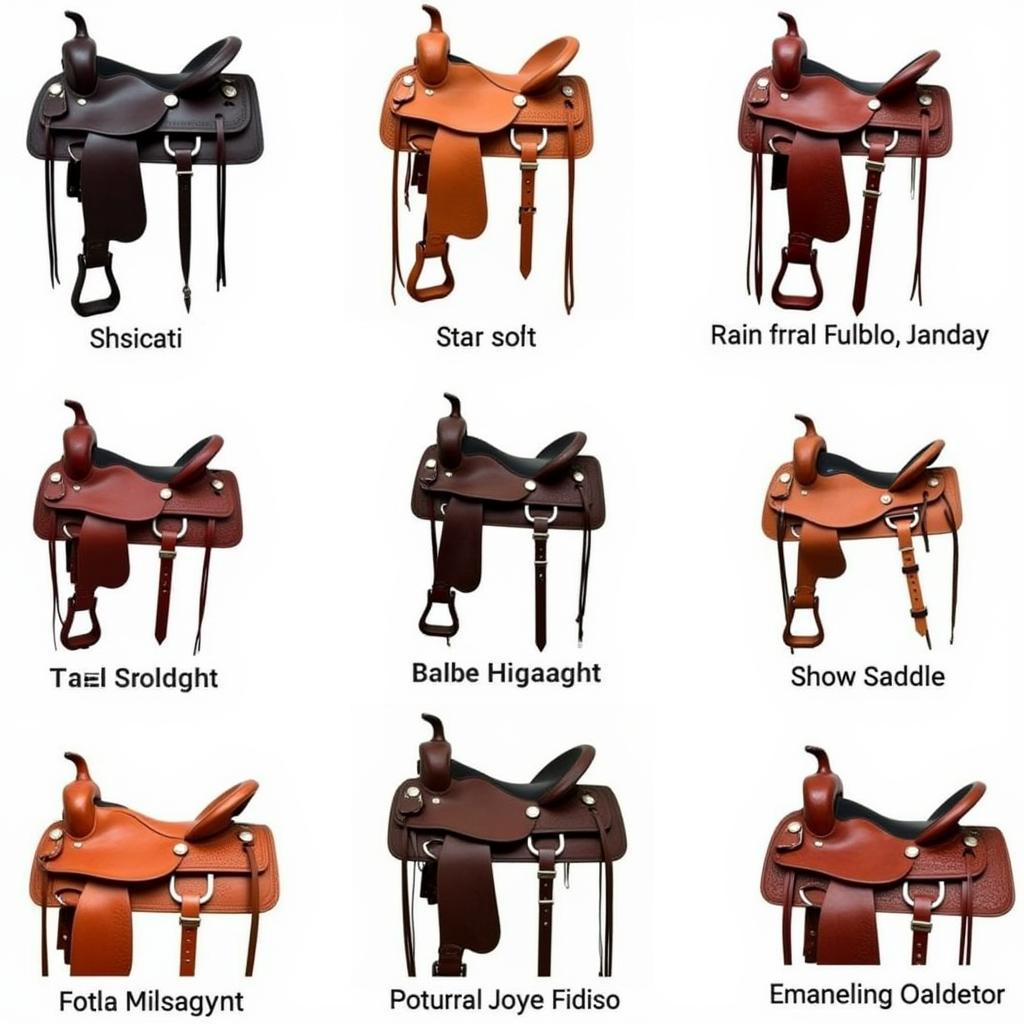Finding the right western saddle for your Arabian horse is crucial for both horse and rider comfort and performance. Arabian horses, known for their shorter backs and higher withers, require specific considerations when selecting a western saddle. This article will delve into the key factors to keep in mind when choosing Western Saddles For Arabian Horses, ensuring a perfect fit and a happy riding experience.
Understanding the Arabian Horse’s Conformation
Before diving into the specifics of western saddles, it’s essential to understand the unique conformation of Arabian horses. Their shorter backs mean that a saddle that’s too long can interfere with their movement and cause discomfort. The higher withers require special attention to avoid pressure points and sores. Considering these unique characteristics is the first step in choosing the right western saddle. [1 breyer horses and tack]
Key Considerations for Saddle Fit
Several key factors contribute to a properly fitting western saddle for an Arabian horse:
- Tree Width: The tree is the internal frame of the saddle. For Arabians, a narrower tree is often preferred to accommodate their shorter backs. A too-wide tree can cause pressure points and restrict movement.
- Gullet Height: The gullet is the channel that runs down the center of the tree. Arabians need a higher gullet to clear their prominent withers.
- Bar Angle: The bars are the underside of the tree that rest on the horse’s back. The angle of these bars should match the horse’s back shape to ensure even weight distribution.
- Saddle Length: As mentioned earlier, a shorter saddle length is essential for Arabian horses. A saddle that extends too far back can interfere with their loin area and hinder their performance.
Different Types of Western Saddles for Arabians
 Different Types of Western Saddles Suitable for Arabian Horses
Different Types of Western Saddles Suitable for Arabian Horses
While many western saddle types can be adapted for Arabian horses, some are more suitable than others:
- Trail Saddles: Trail saddles offer comfort and stability for long rides, making them a popular choice for Arabian owners. Look for a lightweight trail saddle with a narrow tree and high gullet.
- Endurance Saddles: Designed specifically for long-distance riding, endurance saddles prioritize comfort and freedom of movement. These saddles often feature a shorter length and a high gullet, making them a good option for Arabians.
- Show Saddles: For those who participate in western riding competitions, show saddles are designed with aesthetics in mind. However, it’s still crucial to prioritize fit and comfort for your Arabian horse. Look for show saddles with a narrower tree and higher gullet.
Common Mistakes to Avoid
[1 arabian horse saddle]
When choosing western saddles for Arabian horses, avoiding these common mistakes is essential:
- Choosing a Saddle Based on Looks Alone: While aesthetics are important, prioritizing fit and function is crucial for your horse’s well-being.
- Ignoring the Horse’s Conformation: Every horse is unique, and even within the Arabian breed, there are variations in back length and wither height. Always consider your individual horse’s conformation when selecting a saddle.
- Not Seeking Professional Advice: A qualified saddle fitter can be invaluable in ensuring a proper fit. They can assess your horse’s back and recommend the best saddle options.
Conclusion
Choosing the right western saddle for your Arabian horse is an investment in both your horse’s comfort and your riding enjoyment. By understanding your horse’s unique conformation and considering the key factors discussed in this article, you can find the perfect western saddle that allows you and your Arabian companion to enjoy countless hours in the saddle. Remember to prioritize fit, function, and comfort above all else. [1 12 scale horse]
FAQ
- Can I use a regular western saddle on my Arabian horse? While possible, it’s not recommended. Arabian horses often require a saddle with a narrower tree and higher gullet.
- How often should I check my saddle fit? Regularly check your saddle fit, especially if your horse has gained or lost weight or if you notice any signs of discomfort.
- What are the signs of a poorly fitting saddle? Signs of a poorly fitting saddle include dry spots under the saddle, white hairs, sores, and behavioral changes such as resistance to being saddled.
Common Scenarios and Questions
- Scenario: My Arabian seems uncomfortable in his current western saddle. Question: How can I find a qualified saddle fitter to help me?
- Scenario: I’m looking for a western saddle for trail riding with my Arabian. Question: What type of saddle is best suited for long rides?
Further Reading
For more information, you can explore our articles on [breyer horse farm] and [horse for 18 doll].
Need Help?
Contact us at Phone: 0772127271, Email: [email protected], or visit us at QGM2+WX2, Vị Trung, Vị Thuỷ, Hậu Giang, Việt Nam. We have a 24/7 customer service team ready to assist you.